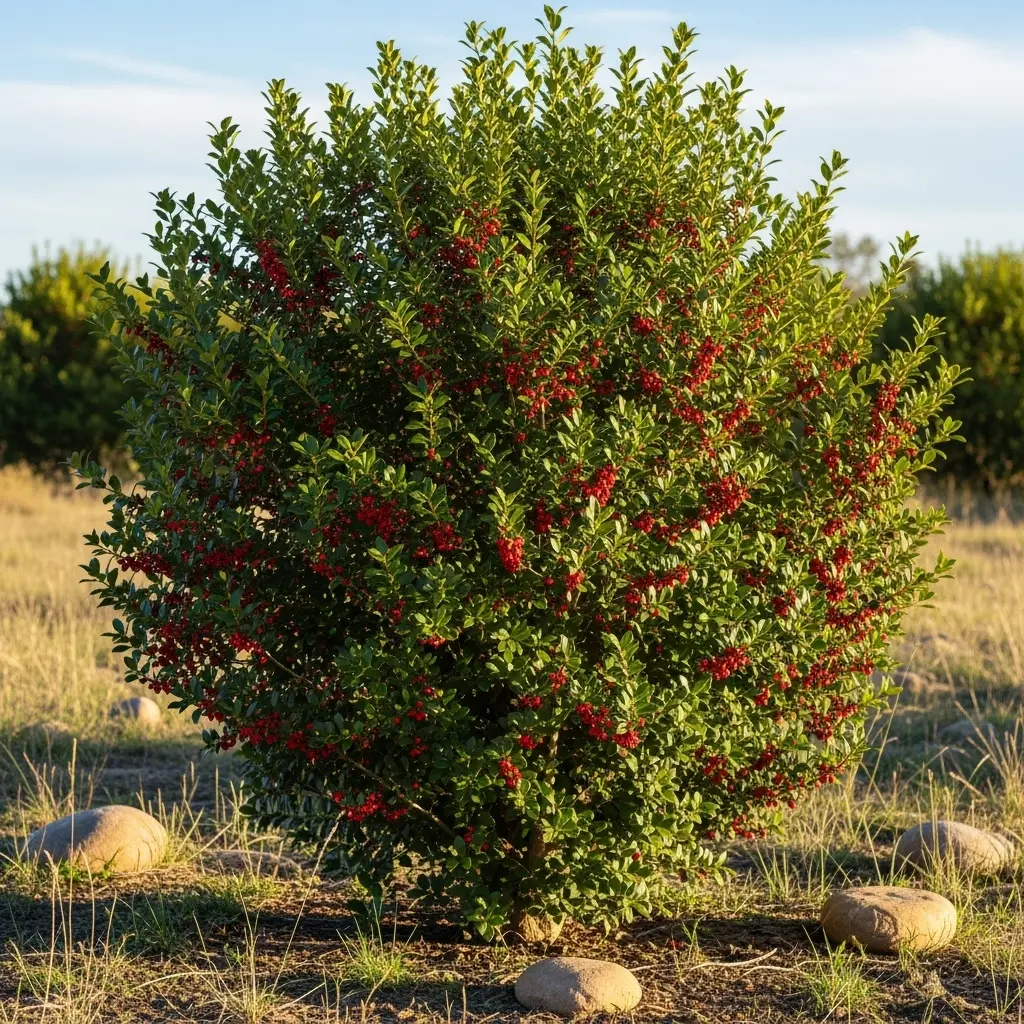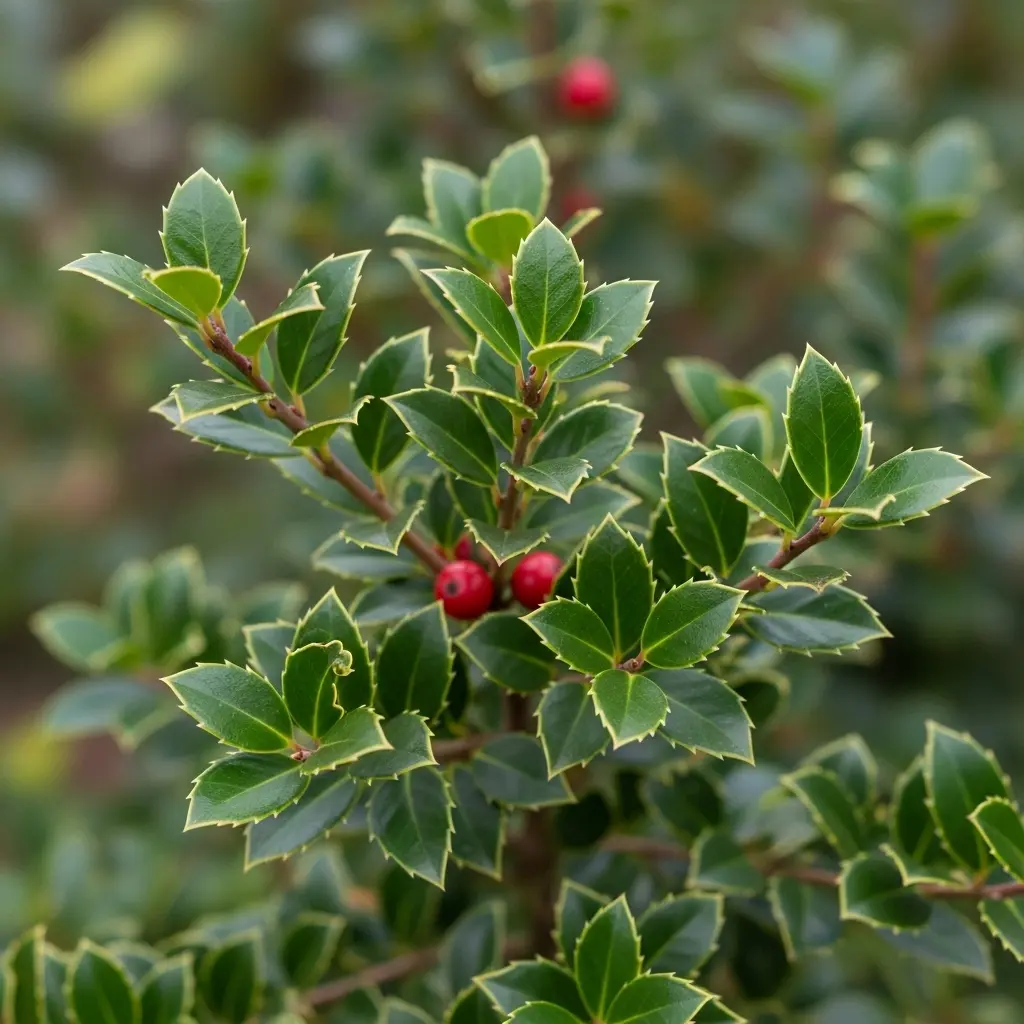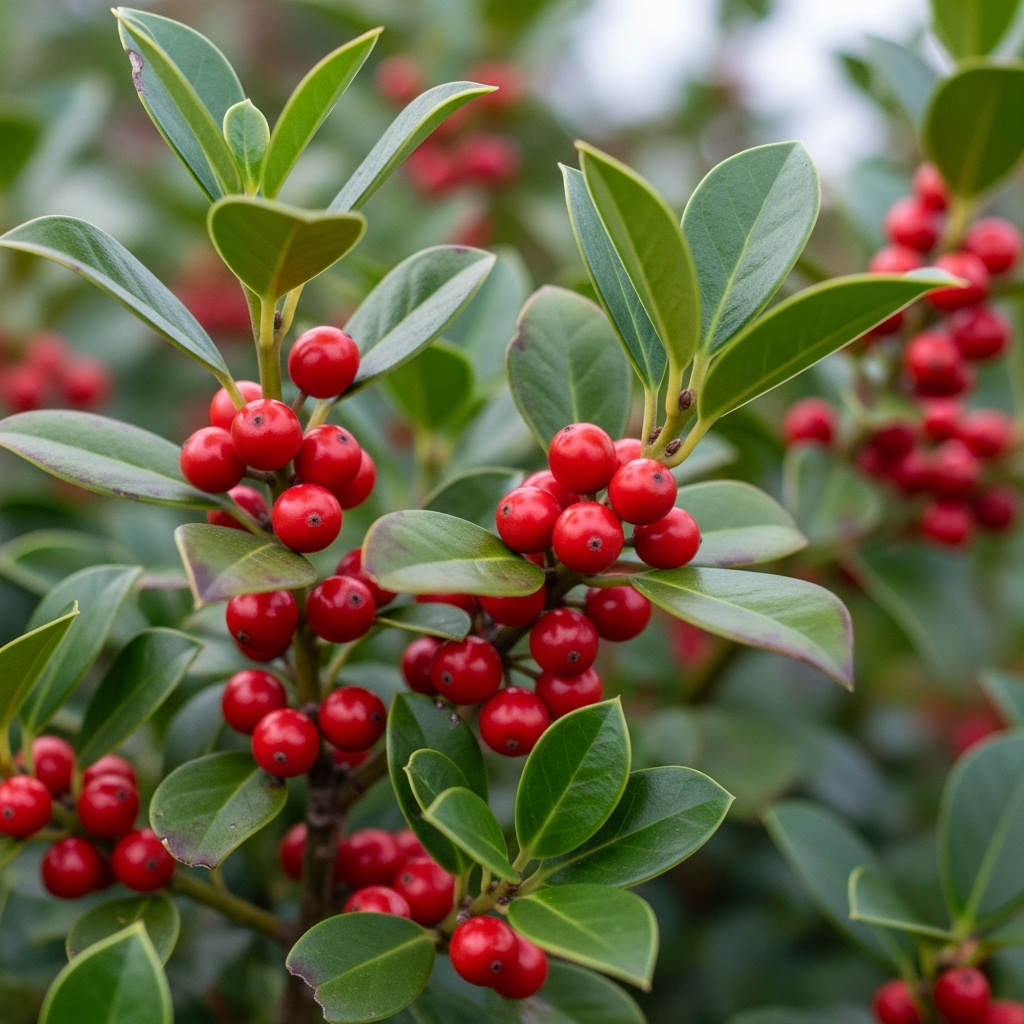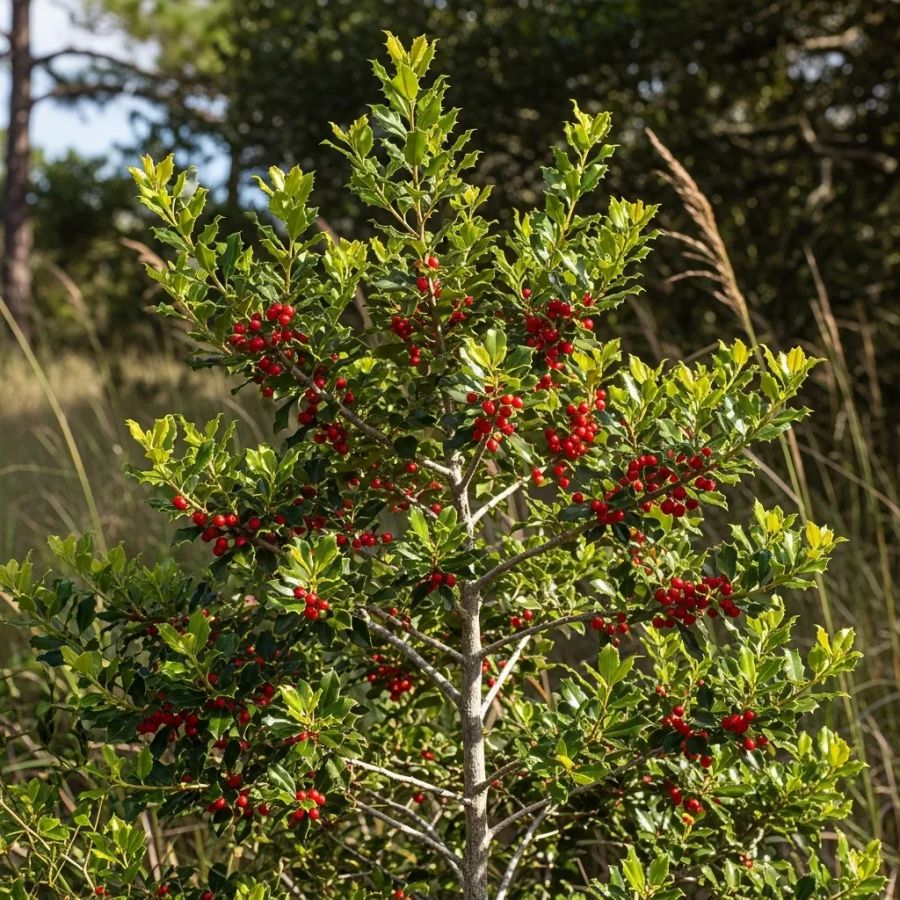Discover how to grow, care for, and propagate yaupon holly, a tough, evergreen native plant that thrives in nearly any condition—from salty coastlines to dry clay soil. Whether you want a privacy hedge, a compact shrub for containers, or a unique tea plant, this guide covers everything you need to grow it successfully.
🌿 Yaupon Holly (Ilex vomitoria) at a Glance
- 🌱 Native Range: SE U.S. (VA to TX)
- 🌿 Evergreen: Yes
- ☀️ Light: Full sun to part shade
- 🌡 Zones: USDA 7a–9b
- 💧 Water: Drought-tolerant once established
- 🐦 Wildlife: Berries attract birds
- 🫖 Tea: Leaves contain caffeine!
- 🦌 Deer: Naturally resistant
If you're looking for a plant that can handle just about anything your garden throws at it, yaupon holly might be your perfect match. This native American evergreen doesn't just survive—it thrives in conditions that would stress out most other plants. Whether you're dealing with coastal salt spray, clay soil, or periods of drought, yaupon holly keeps going strong.
Perfect for privacy screens, foundation plantings, or even as a unique source for homemade tea, yaupon holly adapts to your landscape needs while requiring minimal fuss once established.
Key Takeaways
- Nearly indestructible: Yaupon holly tolerates wet or dry soil, alkaline or acidic conditions, and coastal environments.
- Low maintenance: Requires minimal watering once established and very little fertilizer.
- Versatile sizing: Available in dwarf varieties (2-4 feet) and standard forms that can reach 15-25 feet.
- Year-round interest: Evergreen foliage, spring flowers, and bright red berries on female plants.
- Easy propagation: Grows readily from cuttings or seeds with proper treatment.
Table of Contents
- Getting Started with Yaupon Holly Care
- How to Plant Yaupon Holly Successfully
- Soil and Location Requirements
- Watering Guidelines for Healthy Growth
- Fertilizing (Spoiler: You Won't Need Much)
- How to Prune and Maintain Yaupon Holly
- Growing New Plants from Cuttings
- Popular Varieties and Their Uses
- Common Problems and Solutions
- Next Steps: Enjoy Your Low-Maintenance Success
- Harvesting Yaupon Holly for Tea
If you're looking for a plant that can handle just about anything your garden throws at it, yaupon holly might be your perfect match. This native American evergreen doesn't just survive—it thrives in conditions that would stress out most other plants. Whether you're dealing with coastal salt spray, clay soil, or periods of drought, yaupon holly keeps going strong.
Perfect for privacy screens, foundation plantings, or even as a unique source for homemade tea, yaupon holly adapts to your landscape needs while requiring minimal fuss once established.
Getting Started with Yaupon Holly Care
Yaupon holly (Ilex vomitoria) is the only native North American plant that naturally contains caffeine. But don't worry—you're growing it for its incredible garden performance, not for making tea. This evergreen shrub or small tree grows naturally from Virginia down to Florida and west to Texas.
Important Safety Note: Yaupon holly leaves are highly flammable. Don't plant it within the defensible space around your home if you live in a fire-prone area.
The plant thrives in USDA hardiness zones 7a through 9b, with most gardeners reporting best success in zones 7a-9a. For zones 6a and colder, you'll need winter protection like frost cloth or moving containers indoors. A south-facing wall location provides additional warmth for borderline zones.
Urban environments often work particularly well since the heat-retaining structures create ideal growing conditions.

How to Plant Yaupon Holly Successfully
When to Plant
Plant yaupon holly in early spring, summer, or early fall. The key is avoiding freezing weather during the establishment period. Early spring after the last frost remains ideal, but summer planting works well if you can provide consistent watering.
Choosing Your Spot
Yaupon holly adapts to almost any location, but it performs best with at least 6 hours of direct sunlight daily. While it tolerates shade, you'll get thicker foliage and more berries with more sun exposure.
Planting Steps
Dig your planting hole two to three times wider than the root ball but only as deep as the container. The top of the root ball should sit level with the surrounding soil surface. Backfill with the existing soil—there's no need to amend it unless you're dealing with extremely heavy clay.
Pro Tip: Yaupon holly transplants without shock, making it one of the easiest plants to establish. Even if you need to move an established plant later, it typically handles the stress without missing a beat.
Soil and Location Requirements
This is where yaupon holly really shines. It grows in wet soil, dry soil, clay, sand, acidic conditions, and alkaline conditions. The pH can range anywhere from 6.0 to 7.5 without causing problems, though it tolerates even wider ranges.
For container growing, you'll need a large pot—smaller containers don't provide enough room for healthy growth. Use well-draining potting mix and ensure your pot has drainage holes. The plant appreciates consistent moisture in pots but won't tolerate waterlogged conditions. Container plants in zones 6a and colder need winter protection, either by moving indoors or wrapping with frost cloth.
If you're interested in making your own potting mix for container-grown yaupon holly, check out our DIY Potting Mix guide.

Coastal and Urban Conditions
If you live near the ocean and struggle with salt-tolerant plants, yaupon holly handles coastal exposure beautifully. The salt spray and drought conditions that damage many plants don't phase this tough native. However, avoid heavily polluted urban sites, as the leaves may yellow and growth can become stunted in extremely contaminated areas.
Watering Guidelines for Healthy Growth
During the first year, water your yaupon holly deeply but less frequently—about twice a week if it's not raining. This approach encourages deeper root development rather than shallow surface roots. Deep, infrequent watering creates a more drought-tolerant plant in the long run.
Don't panic if your plant loses leaves from stress—yaupon holly is a tough customer and usually bounces back with a little TLC. Just don't plant it right before a cold snap, as yaupon doesn't love icy surprises during establishment.
Once established (after the first growing season), yaupon holly becomes remarkably drought-tolerant. You'll only need to provide supplemental watering during extended dry spells in summer.
Watering Test: Stick your finger 2-3 inches into the soil near the plant. If it feels dry at that depth, it's time to water. If it's still moist, wait a few more days.
Fertilizing (Spoiler: You Won't Need Much)
Here's some good news for your wallet and your schedule: yaupon holly doesn't need much fertilizer to thrive. In fact, too much nutrition can actually cause problems.
If you choose to fertilize, apply a balanced, slow-release fertilizer like 13-13-13 in early spring, but use it sparingly. Avoid high-nitrogen fertilizers and lawn fertilizers—they can burn the roots and promote excessive leaf growth at the expense of the plant's natural form and overall health.
For newly planted yaupon hollies, wait 4-6 weeks after planting before applying any fertilizer. The plant needs time to settle in before you start pushing new growth.
If you prefer organic options, see our Organic Fertilizer Guide for natural ways to feed your plants.
Fertilizer Warning: Avoid high-nitrogen fertilizers. They can damage the delicate root system and create weak, excessive growth that's more susceptible to problems.
How to Prune and Maintain Yaupon Holly
Yaupon holly needs very little pruning to look its best. The natural growth habit is attractive on its own, and over-pruning can actually detract from the plant's character.
Light pruning in late winter or early spring, before new growth starts, helps maintain shape and removes any dead or damaged branches. Avoid heavy pruning, especially when new growth is present, as this can stress the plant. For hedges or formal shapes, you can prune more regularly, but remember that you'll be removing potential flowers and berries.
Mulching for Success
Apply a 2-inch layer of mulch around the base of your yaupon holly to help retain moisture and regulate soil temperature. Keep the mulch a few inches away from the trunk to prevent rot and pest issues. Organic mulch like shredded bark or compost works well.
Size Management
Standard yaupon holly can reach 8-12 feet tall (sometimes larger), but dwarf cultivars like 'Schillings Dwarf' grow much slower and typically max out around 6x10 feet. Your final plant size depends heavily on the variety you choose and your pruning routine.
Seasonal Maintenance
- Spring: Light pruning if needed, and apply mulch around the base (but not touching the trunk).
- Summer: Monitor for pests and water during dry spells.
- Fall: Add fresh mulch to help with winter protection.
- Winter: Generally maintenance-free.

Growing New Plants from Cuttings
From Cuttings (Easiest Method)
Take 4-6 inch cuttings from healthy new growth in late spring or early summer. Remove the lower leaves, dip in rooting hormone, and plant in well-draining potting mix. Keep moist and in indirect light until roots develop in 6-8 weeks.
From Seeds (For Patient Gardeners)
Seed germination requires patience and specific conditions. Fresh berries need to go through a warm period (at least one month) followed by a cold period (2-3 months) to break dormancy. Soak seeds, then refrigerate for 30 days before planting 1/4 inch deep in well-draining soil.
Gender Matters: Only female plants produce the attractive red berries, and you need both male and female plants for berry production. Most nurseries label the gender, but if you're propagating from your own plants, you won't know until they mature.
Popular Varieties and Their Uses
Yaupon holly offers excellent variety in size and form to fit different landscape needs. Here's a breakdown of the most popular types:
| Type | Height | Best Use | Berries | Notes |
|---|---|---|---|---|
| Dwarf ('Schillings') | 2–4 ft | Foundation, borders, containers | Usually male (no berries) | Great for low hedges, slow growing |
| Standard | 8–12 ft | Screens, specimen trees | Yes (female plants) | Most common, very adaptable |
| Weeping | 8–15 ft | Accent, ornamental feature | Yes | Graceful form, requires more space |
Each variety maintains the same low-maintenance, adaptable nature that makes yaupon holly such a reliable garden performer. Note that you'll often find conflicting size information online—actual results depend heavily on your specific cultivar and growing conditions.
Common Problems and Solutions
The beauty of yaupon holly is that problems are rare. Here are the few issues you might encounter:
- Yellowing leaves: Usually indicates overwatering. Reduce watering frequency and ensure good drainage.
- Thin, sparse growth: Typically means insufficient sunlight. Consider relocating or pruning nearby plants to increase light exposure.
- No berries on mature plants: You either have a male plant, need a pollinator nearby, or the plant isn't getting enough sun for flower and fruit production.
- Slow establishment: While rare, some plants take longer to settle in, especially in colder zones or container growing situations. Continue consistent watering and be patient—yaupon holly rarely fails to thrive once established.
- Pest issues: Generally pest-resistant, but occasionally inspect for aphids or scale insects. Disease problems are rare in home garden settings.
- Defoliation from stress: Don't panic if cold snaps or drought cause leaf drop. Yaupon holly often recovers fully with just a bit of care.
Next Steps: Enjoy Your Low-Maintenance Success
Growing yaupon holly is one of the most rewarding and low-stress gardening experiences you can have. Once you plant it and help it get established in that first year, you can essentially step back and let it do its thing.
The combination of evergreen foliage, seasonal interest from flowers and berries, and incredible adaptability makes yaupon holly a smart choice for gardeners who want maximum impact with minimal effort. Whether you choose a compact dwarf variety for a small space or let a standard form grow into a privacy screen, you're investing in years of reliable garden performance.
Ready to get started? Have you grown yaupon holly in your yard, or are you planning to add one? Share your experience or questions in the comments below—we'd love to hear from fellow yaupon enthusiasts!
Harvesting Yaupon Holly for Tea
Here's something most gardening guides don't mention: yaupon holly is North America's only native caffeine-containing plant, and its leaves make an excellent tea! If you're interested in this traditional use, here's what you need to know.
When and How to Harvest
You can harvest yaupon leaves year-round, though spring and summer growth tends to have the best flavor and caffeine content. You'll need to be patient—it takes several years for plants to develop enough foliage for meaningful harvests, especially with smaller plants or in colder climates.
Did You Know? Native American tribes in the Southeast used yaupon tea in purification ceremonies. Early European settlers called it "black drink" and adopted it as a coffee substitute.
Processing Your Harvest
Fresh yaupon leaves can be quite bitter, so mild processing brings out a smoother, more enjoyable flavor.
- For Light Tea: Air-dry leaves in a well-ventilated area for 2-3 weeks, then brew like regular tea.
- For Dark Tea: After air-drying, roast the leaves in a 350°F oven for 10-15 minutes until they turn darker brown. This creates a richer, more coffee-like flavor.
Taste and Safety Notes
Properly prepared yaupon tea has a smooth, grassy flavor with less bitterness than traditional teas. The roasted version develops nutty, almost coffee-like notes. The caffeine content is moderate—less than coffee but more than most teas.
Safety First: Only harvest from plants you've grown yourself without pesticides. Start with small amounts to test your tolerance. Pregnant women and people sensitive to caffeine should consult their doctor first.
Dwarf varieties yield less leaf material but are easier to manage for regular harvesting in smaller gardens.
Frequently Asked Questions
How fast does yaupon holly grow?
Moderate growth rate, typically 12-24 inches per year once established. Dwarf varieties grow much more slowly and may take several years to reach mature size.
Is yaupon holly deer resistant?
Yes, deer typically avoid yaupon holly, making it excellent for areas with heavy deer pressure.
Can I grow yaupon holly indoors?
While possible with large containers and adequate light, it's challenging. The plant really prefers outdoor conditions. If you try indoor growing, provide 12-16 hours of bright light daily.
What should I do if my plant loses all its leaves?
Don't panic. Yaupon holly often defoliates from stress (cold, drought, transplant shock) but typically recovers with proper care. Continue appropriate watering and wait for new growth.
Why do I find conflicting information about plant size online?
Size depends heavily on the specific cultivar, growing conditions, and pruning practices. Always check the variety name and expect some variation from published sizes.
How do I know if my plant is male or female?
You'll need to wait for flowers. Males have small clusters of flowers, while females have fewer, less showy flowers that develop into berries.
Is yaupon holly invasive?
No, yaupon holly is not considered invasive. As a native plant, it's actually beneficial for local ecosystems and provides food for wildlife.
How long does it take for yaupon holly to reach full size?
Standard varieties typically reach mature size in 5-10 years, while dwarf varieties may take 8-15 years due to their slower growth rate.
What's the difference between yaupon holly and other hollies?
Yaupon holly has smaller leaves and is more drought-tolerant than most other holly species. It's also the only holly native to North America that contains caffeine, making it unique among American native plants.
